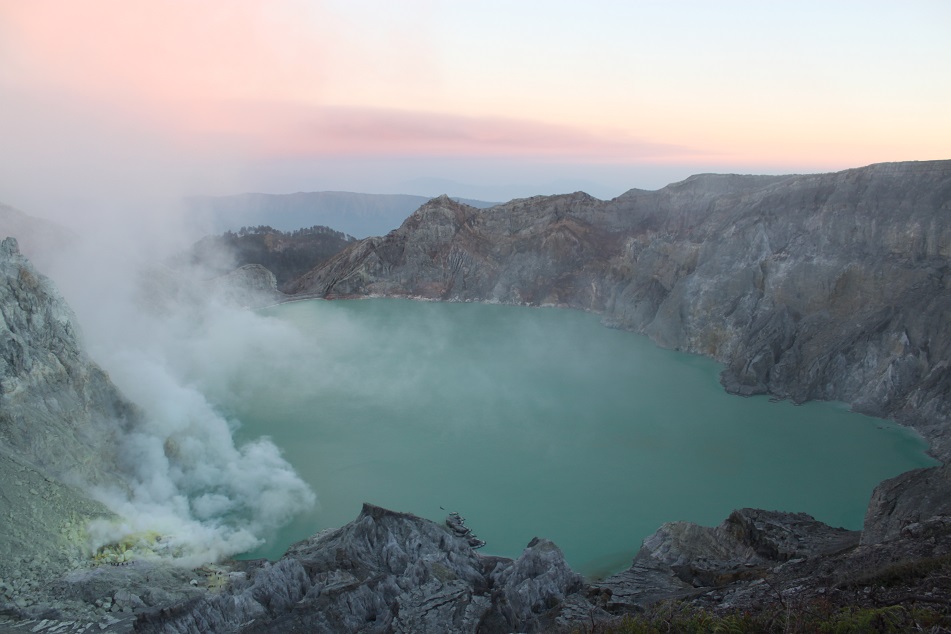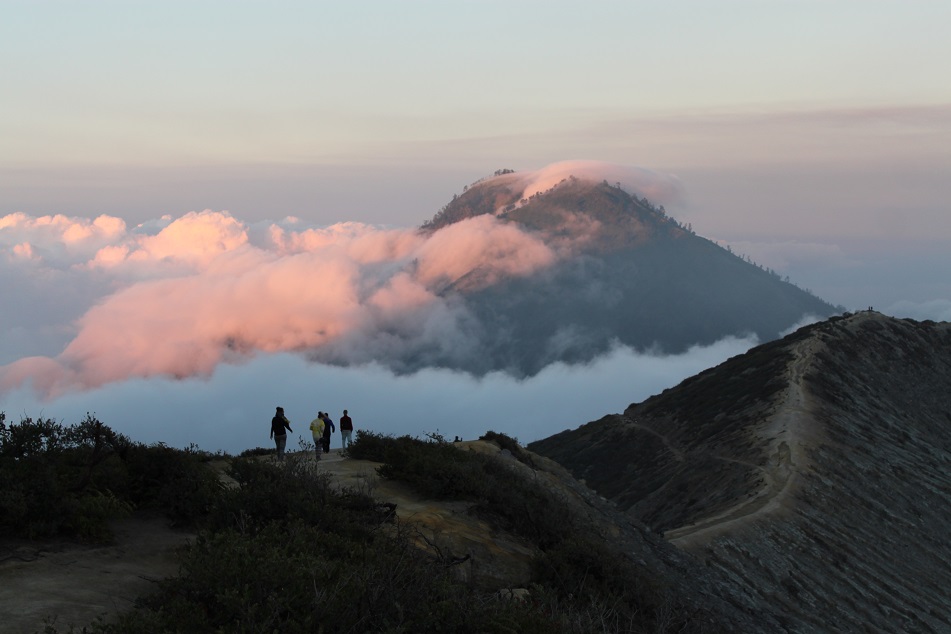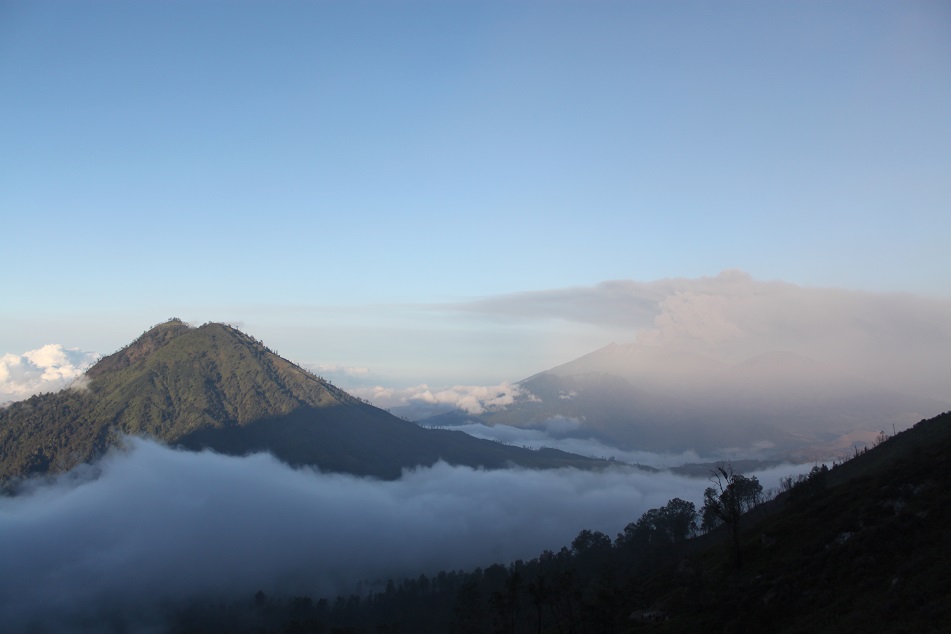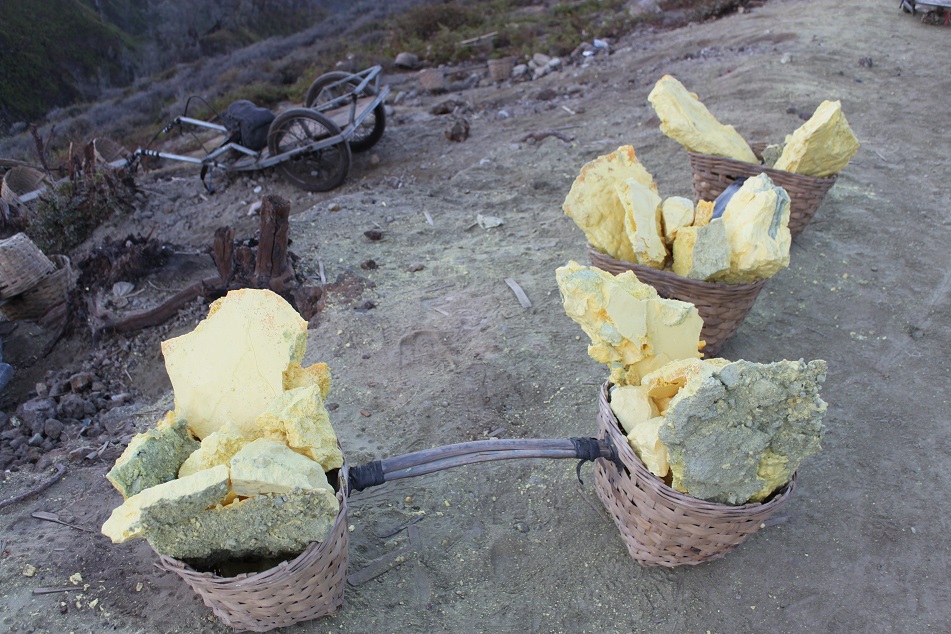Any conversation about Indonesia’s natural landscape will almost certainly mention its plethora of volcanoes. Located on the Pacific Ring of Fire – where some of the world’s strongest and deadliest earthquakes and volcanic eruptions occur – Indonesia is home to more than a hundred active volcanoes, more than any other country on the planet. Arguably among the most famous is Krakatau (also spelled Krakatoa) whose cataclysmic eruption in 1883 obliterated the volcano itself and wiped out villages on the shores of nearby islands. Its explosion was 13,000 times more powerful than the atomic bomb Little Boy which was dropped on Hiroshima, and it was so loud it could be heard as far as Mauritius, thousands of kilometers away from the volcano.
As someone who was born and raised in Indonesia, I’m lucky enough to have visited some of the archipelago’s most iconic volcanoes, including the relatively easy to reach Mount Bromo, the very challenging Mount Rinjani, as well as Mount Api which served as a natural landmark for sailors and explorers who reached the fabled Spice Islands in the past. Java, the world’s most populous island where the Indonesian capital is located, became so crowded largely thanks to its fertile soil, a gift from the volcanoes themselves. They take lives, but they also provide a fresh start for new lives. At the eastern end of Java, however, lies a volcano which is more tame than its sisters on the island but takes lives in a different manner.
To get there, James and I take the train from Surabaya – East Java’s capital and largest city as well as Indonesia’s second largest metropolis – to Banyuwangi at the very end of East Java. I have arranged a pick up service with our hotel in our destination anticipating the lack of transportation options in the city of a little more than 100,000 residents. But as we arrive at the very modest train station, no one from the hotel is there, another moment during our travels when we are reminded to slow down and chill. A phone call and a few minutes’ wait away, the van finally arrives.
Literally ‘fragrant water’, Banyuwangi was the seat of power of Blambangan, the last Hindu kingdom in Java before most Javanese Hindu royal families fled to Bali just across the strait. Home to the Osing people, a Javanese sub-ethnic people who were among the last in Java to convert to Islam, Banyuwangi has only begun developing its nascent tourism industry in recent years, hoping to attract some tourists who visit Bali to the east or Mount Bromo to the west. A friend who went to some of Banyuwangi’s beaches raved about their beauty, a claim further justified by his stunning photos. But for now, Banyuwangi is still better known as the gateway to Mount Ijen, famous for its sulfur mining, turquoise acidic lake, and blue fire.
In the wee hours of the next morning, we are already inside a four-wheeler jeep which will take us to the start of the hiking trail to the crater of Ijen. Relying only on our torches and the silhouettes of other tourists in front of us, we hike the dark pathway at a steady pace. After more than a year going to work by bike, I’m in much better shape than when I climbed Rinjani two years earlier. However, when we are not too far from the crater rim, suddenly altitude sickness hits me as I start feeling nauseous. At more than 2,700 meters above sea level, Ijen clearly is a lot higher than Jakarta, the low-lying metropolis I’ve been calling home since 2008.
Taking a few minutes’ break not only allows me to gain some energy, but it also gives us ample time to look up to the skies, where millions of stars shine like I’ve never seen before. As wise people say, in life sometimes we have to stop for a while to give our body, mind and soul the rest they deserve. For this brief break I take, the reward is none other than one of nature’s most awe-inspiring sights. After regaining a little strength, I carry on, followed closely by a slightly-worried James, and together we arrive at the crater rim moments before sunrise. From above, we can see people going down the crater to reach a corner of the lake where molten sulfur hardens, which is later mined by the local men. Occasionally electric blue flames blow into the putrid and suffocating air, which is typical of any sulfurous volcanic crater. Even from above, the fire – ignited sulfuric gas which escapes from cracks at a high temperature – looks mesmerizing. But the incredible sight probably impresses the local men less as they have to work in such a dangerous environment to make ends meet.
Slabs of hardened sulfur are quarried and carried every day to a nearby village, where the men’s arduous labor is then rewarded with just enough money for them to support their families. Prolonged exposure to the acidic gas has proven detrimental to the local men’s health as their life expectancy is significantly lower than the national average. Not far from us, a miner takes a brief stop. Upon seeing this some tourists ask for his permission to lift the shoulder pole, tied with rattan baskets at both ends which are filled to the brim with sulfur slabs, for the sake of curiosity. They are unsurprisingly heavy as I try to lift them up myself.
These yellow materials are not gold, and worth much lower than the precious metal. But to the locals the sulfur is their ‘gold’, and despite the hardship the men have to endure every day, they will carry on working under such conditions, which will probably drive the young people away from the village and into the cities to make more money than what their fathers earn. The sun slowly rises behind the clouds, giving the horizon a warm, melancholic tint. Behind us, Mount Raung which awoke several days earlier from its long slumber is still puffing a thick cloud of gray ash after causing major disruptions to flights around Java and Bali for days.
Mother Nature is strange. It is at ‘dangerous’ places like this where we usually witness her magnificence – beauty in chaos. In places like this, some humans have to live challenging lives. Yet, for others these very places can provide them with the peace and tranquility they’ve been deprived of elsewhere. Mother Nature takes and gives lives as she has always done for aeons.
















Wow, beautiful shots and fascinating narrative. I missed Indonesia when I was in that part of the world but I will return.
LikeLike
Appreciate your kind words! Hope that day when you return to Indonesia comes sooner than later. 🙂 Thanks for reading!
LikeLike
Your blog shows with every post how much you love your country. The pictures and your report are of outstanding quality. I learned that you have the most volcanoes on the planet and they appear to be also the most violent and dangerous ones. I am eager to read your next episode, Bama.
LikeLike
As a matter of fact, one of the reasons why I started this travel blog was to showcase interesting places in Indonesia to the international audience. Back then, most people only heard about Bali, and speaking of the island itself there are so many corners of Bali even many Indonesians are not aware of. Always appreciate your comment, Peter. As for the Indonesian volcanoes, there is another volcano in eastern Indonesia worth mentioning. Mount Tambora erupted in 1815 and by far it is the largest volcanic eruption in recorded history. It was so powerful it caused global climate anomalies. Maybe one day when I go to Tambora I will write about this.
LikeLiked by 1 person
I heard about Mount Tambora. Its eruption caused a mini ice age with crop failures in Europe. I am looking forward to your future post on that volcano, Bama.
LikeLike
First I need to find out how to get there. It’s not the easiest place in Indonesia to reach.
LikeLiked by 1 person
India and Indonesia have so much in common but Volcanoes is not one among them!!!!
LikeLike
Exactly! However, according to an old Javanese story the island of Java was once floating and constantly shaking. The gods took Mount Mahameru from India and put it on the western part of Java. This caused the island to tilt, which forced the gods to transport the mountain to the eastern part of the island. On their way, fragments of the mountain dropped along the island, creating volcanoes which still exist in modern time. Finally the gods placed the top of the mountain in the east, creating Mount Semeru, Java’s highest volcano. So in that sense, both Indonesia and India are still closely related. 🙂
LikeLike
I read about the Sulphur farmers of Ijen. I would definitely like to visit this place.
LikeLike
The crater was very beautiful, indeed. I wonder if you should bring a mask when you go to Ijen, especially if you plan to go down to where the blue flames are.
LikeLike
You need a chemical gas mask which is kinda restrictive.
LikeLike
Or, you can do what other people do: go down without a mask, quickly take some shots, and go back.
LikeLiked by 1 person
wonderful photography… and lovely narration……
LikeLike
Much appreciated, Sudhir! This is a place mountain lovers should not miss.
LikeLiked by 1 person
Like many I’ve only ever passed through….perhsps nect time I’ll stop and smell the sulphur anf take in the awesome views…..awesome pics!!
LikeLiked by 1 person
Smelling the sulfur is definitely not something I look forward to experiencing every time I go to a volcano. However, it is inseparable from the adventure itself. So now I’m getting used to it… kind of. Thanks Trees!
LikeLike
Bama, you already know about my enduring fascination with volcanoes, so it’s not surprising to see why I ended up here in Indonesia! Banyuwangi was a pleasant surprise – although I wasn’t thrilled and a bit stressed out with our less-than-ideal room at the hotel! I’d love to go back and see how it is doing now that there’s a brand-new airport terminal and direct flights from Jakarta. The sunrise hike to Ijen was an unforgettable (I too have never seen so many stars, much less a volcano mid-eruption!) but sobering experience… there has to be a way for those sulfur miners to make a better living with far less dangerous work.
LikeLike
I guess all of your readers have figured that out already. 🙂 The southern beaches of Banyuwangi are supposed to be really nice, so we can check them out the next time we go (when Raung or Semeru are not erupting, though). Hopefully Banyuwangi can manage its tourism industry in sustainable ways!
LikeLiked by 1 person
All your pictures are great. Really love the one of the craters!
LikeLiked by 1 person
Thanks John and Susan! The lake, the gas, the patterns on the crater’s walls, all of them was a showcase of Mother Nature’s force. Truly majestic indeed!
LikeLike
Your photos deserve a place in National Geographic magazine. So amazing, especially the pink hue sky over the blue crater! It must be a lot of effort to be able to capture these pictures. Hats off to you and James 🙂
LikeLike
Thanks Len, you’re too kind! We were lucky the weather was quite nice that day which allowed us to see those stars as well as Raung’s eruption after sunrise.
LikeLiked by 1 person
A wonderful post Bama that transported me there in my mind, and makes me want so badly to get to Indonesia to explore all its wonders. One day . . . . . .
Alison
LikeLike
Much appreciated, Alison! When you do come to Indonesia, please do let me know. I’ll do my best to help you plan your trip, and if you have a day or two in Jakarta, James and I will definitely be more than happy to take you around.
LikeLiked by 1 person
Dengar-dengar disana sekarang ada jasa becak-gerobak buat pendaki yang ‘malas’. Kemarin sempat lihat juga gak Bam?
O iya, waktu ideal untuk mulai trekking ke atas jam berapa?
LikeLike
Hmm, waktu aku di sana sih gak inget liat yang begituan ya. Tapi kalaupun ada becak/gerobak kok aku malah ngebayanginnya kasian yang narik becak/gerobaknya. Kalau naik kuda sih masih agak mending ya soalnya kaki mereka kan memang kuat.
Waktu itu kami berangkat dari hotel jam 2 pagi, dan sampai di titik awal pendakian kayaknya sekitar jam 3. Pas sampai di bibir kawah masih gelap. Jadi harusnya kalau berangkat dari Banyuwangi jam 2 sih masih kekejar liat sunrise (dengan tempo pendakian yang normal).
LikeLike
Nah iya Bam, itu juga yang aku pikirin. Kasian banget si tukang gerobak nya. Tapi konon itu memberi pemasukan yang lebih lumayan daripada angkut belerang.
Jadi lumayan jauh ya jarak hotelnya sampai ke titik awal pendakian. Untuk antar jemputnya ada providernya kah?
LikeLike
Kalau lihat di peta sih jarak dari pusat kota Banyuwangi ke Kawah Ijen sekitar 30an km. Jadi ya wajar lah ya sekitar satu jam perjalanan.
Duh beneran gak bisa ngebayangin deh naik ke kawah pake gerobak. Itu jalurnya kan ditutupi abu vulkanik gitu.
LikeLiked by 1 person
Mirip kayak di Bromo itu ya mas Bart? jasa orang buat bawain ke atas entah barang atau kitanya?
LikeLiked by 1 person
Di Bromo juga ada? Bukannya di sana pakai kuda ya ko?
LikeLike
This place is amazing!
LikeLike
Yes it is, Myra! Nature’s violent forces created this beautiful place.
LikeLike
What an absolutely stunning volcano! Wow! I had no idea that Indonesia had so many volcanos. Very beautiful.
LikeLiked by 1 person
Speaking of volcano, I remember one of your earlier posts about witnessing a volcanic eruption in Guatemala, if I’m not mistaken. When you do come to Indonesia one day, you have a lot of volcanoes to choose from, Nicole! 🙂
LikeLiked by 2 people
Yes I did! 🙂 Great memory Bama.
LikeLiked by 1 person
What a beautiful blog post again. I have never seen volcanoes in real life as we have none in Nepal, and the few places in Europe where they are found, I haven’t been yet. So it was great to take a photo tour to one of Indonesia’s through your post today. It looks vast, fascinating and serene, although probably just from a distance.
LikeLike
But you have all those majestic snow-capped peaks in Nepal. 🙂 Really appreciate your kind words, Pooja! Watching Mount Raung puffing that thick column of volcanic ash was such a surreal experience. At the same time, the crater of Mount Ijen provided a serene and beautiful backdrop. It was magical!
LikeLike
Terus aku melongo membaca tulisanmu yang bahasanya perlu lama aku cerna 😀
LikeLike
Waduh, mungkin butuh probiotik supaya lebih lancar mencernanya. 😀 Terima kasih ya sudah mampir di blog saya.
LikeLike
I knew some great photos were coming of that sunrise on top of the volcano, but you’ll be happy to know I forced myself to read slowly and savor the views as I slowly scrolled! I really liked your thought that “beauty is chaos” and that it is in some of the most dangerous places that we can see this kind of beauty. I liken the work here to the coal miners’ work in states like West Virginia is the U.S. That state is one big gorgeous hilly forest, but under its mountains, miners gasp and toil to extract “black gold.” It saddens me, not just their unhealthy labor, but what it ultimately does to the environment it comes from and the environment it later pollutes.
LikeLike
I giggled at the part where you forced yourself to read slowly — thanks Lex! Quite the opposite of the idea of “beauty is chaos” is how orderliness can prove dull and boring. Somewhere in the middle usually works best, because wise people say moderation is key to all good things in life. Indonesia is the world’s fifth largest coal producing country (after China, India, the U.S., and Australia), but that is something I’m not really proud of given coal’s highly-polluting nature no matter how “clean” coal companies claim their products are. It’s so sad to hear about the work condition for coal miners in West Virginia, and the EPA’s budget cut will surely make things worse.
LikeLiked by 1 person
I’m right there with you on the coal. And I strive to be a person of moderation in every way, so that rings very true also!
LikeLike
This region is very interesting for me. I don’t know how many days I should spend to enjoy the city, the beach, the crater, and Baluran. I’m not sure a week will be enough. As years go by, I realized that I’m a kind of traveler that needs more time than others to enjoy a place. Also, I need several times for a shot, and I need a really proper sleep (about 8 hours) on my trip 😀
Anyway, my latest post is written in English, maybe you’re interested in reading it 🙂
LikeLike
I would love to go back to Banyuwangi to explore the beaches as well as Alas Purwo. I think two weeks would be the ideal amount of time to spend in this part of Java, but sometimes we just don’t have that luxury, do we? I, too, like to take lots of photos of the same object, making sure that I get at least one clean shot of it. But that means I always end up having hundreds, even thousands of photos to choose from when I return to Jakarta. 😀
LikeLiked by 1 person
Nah, aku biasanya langsung memilih foto terbaik untuk obyek itu saat itu juga 😀
LikeLike
Ooo foto yang kurang oke langsung dihapus ya berarti? Emang mendingan gitu sih, biar gak menuh-menuhin harddisk. 🙂
LikeLike
Yup. Jadi tugasnya gak numpuk haha, and saves memory for the next pictures
LikeLike
Oh Bama what an adventure! I felt as though I was with you and James every step and certainly wish I had been. Altitude sickness can come upon one so quickly. Dave got very ill in Peru and he is far stronger than I So one just never knows. Your photos are stunning and oh my those baskets look terribly heavy loaded.
LikeLike
This is something you and Dave should do when you come to Java one day! I have a feeling both of you will do much better than I did thanks to all those outdoor activities you’ve been doing. Oh and mind the putrid odor, by the way! Thanks Sue!
LikeLiked by 1 person
We shall put it on the list Bama! It looks very intriguing. Not sure how we would do with the climb. As We learned in Peru you never know how it will affect you.
LikeLiked by 1 person
Beautiful post Bama, with your perspective on ‘Beauty in chaos’ and your compassion for the sulphur miners. Glad you made it to the top and captured that sunrise to share with us. The closest I have been to a volcano is in Santorini 🙂
LikeLike
Thanks Madhu! Those miners have been featured in several international publications, including NatGeo, for exactly the same reason I mentioned in this post. In a beautiful setting like Mount Ijen, some people work arduously to make ends meet.
Ahh, Santorini.. One of the places I’ve been dreaming to visit in my life! — although probably I have said this for too many times since there are just so many marvelous places around the world.
LikeLiked by 1 person
beautiful post !!
LikeLike
Thanks Dini!
LikeLike